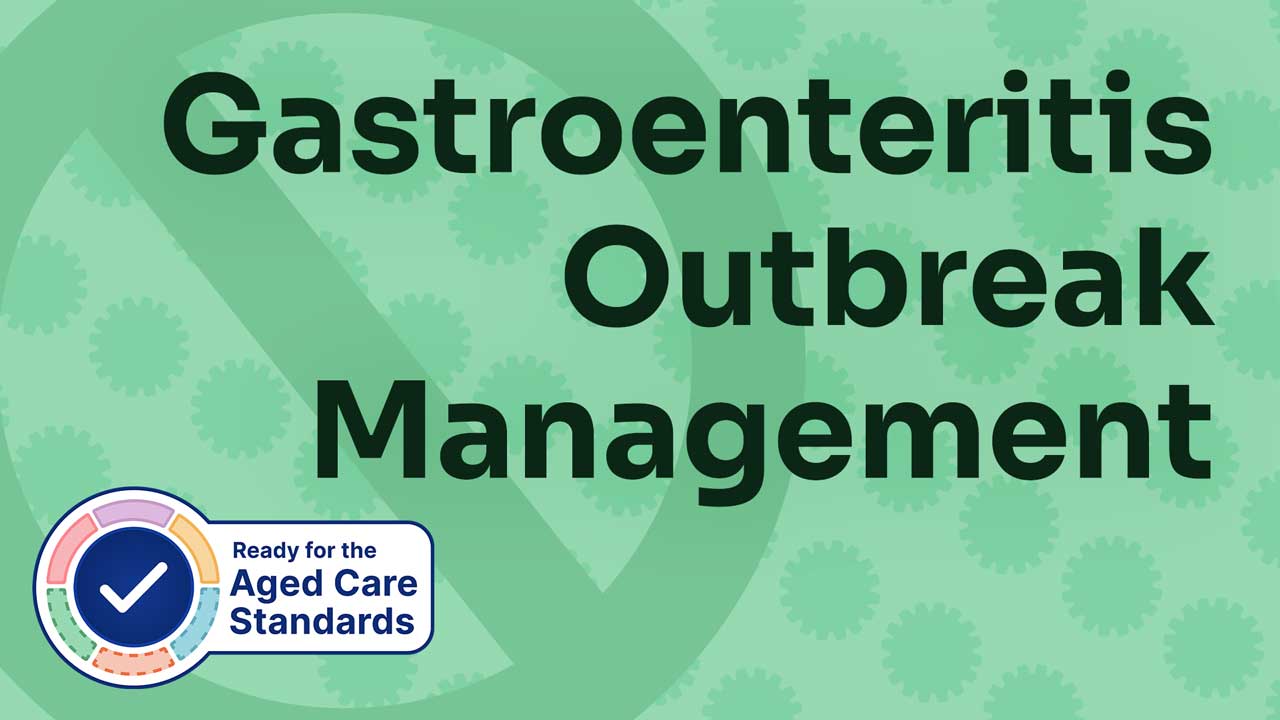Did you know aged care residents are particularly susceptible to gastroenteritis outbreaks?
An Australian survey of residential aged care services conducted between 2017 and 2018 found that during the previous 12 months, 30% of organisations had experienced a gastroenteritis outbreak affecting both residents and staff (AACQA 2018).
Infectious disease outbreaks in aged care often cause significant illness and distress and lead to adverse impacts on staff, resources, and residents' activities (Latta et al. 2018).
There are a variety of factors that increase the likelihood of a disease being brought into and spread around a facility, including:
- Comorbid medical conditions among residents
- High-density living arrangements
- Frequent contact with visitors and staff
- Hospital admissions and transfers from other facilities
(Latta et al. 2018)

Outbreak Management Under the Strengthened Aged Care Quality Standards
Standard 4: The Environment - Outcome 4.2: Infection prevention and control under the strengthened Aged Care Quality Standards (Action 4.2.1) requires aged care providers to establish an infection prevention and control system that includes precautions for quickly responding to suspected or confirmed infectious disease outbreaks (ACQSC 2024).
What is an Outbreak?
In order to classify as an outbreak, a disease must occur suddenly and in excess of what would typically be expected in a specific community, geographical area or season (Ward 2020).
It’s worth knowing how to define an outbreak as distinct from an epidemic or pandemic:
- An epidemic is an outbreak that occurs over a larger geographic area. Examples include yellow fever and smallpox.
- A pandemic is an epidemic that has spread globally, causing social disruption, economic loss and hardship - for example, COVID-19.
(Fischer 2020; ALA 2022)
What is Gastroenteritis?
Read: Gastroenteritis Symptoms, Spread and Prevention
Gastroenteritis is a condition caused by infection and inflammation of the digestive system (Better Health Channel 2021).
It’s generally a short-term illness, with symptoms commonly including abdominal cramps, diarrhoea and vomiting. Potential causes of gastroenteritis include viruses, bacteria, bacterial toxins, parasites, chemicals and some medicines (Better Health Channel 2021).
Infectious gastroenteritis spreads easily from person to person or via contaminated food or water. Infection control measures such as hand washing are particularly important in preventing the spread of gastroenteritis (Healthdirect 2023).
Recognising Gastroenteritis Outbreaks
A gastroenteritis outbreak is generally defined as two or more people (residents and/or staff members) experiencing vomiting and/or diarrhoea in the same institution within a period of 24 hours, which cannot be explained by medicines or other medical conditions (DoHA 2011; DoHHS 2019).
In the situation of a suspected outbreak, a case definition is required. This is a set of criteria used for determining what should be classified as a case (DoHA 2010).
An outbreak management team forms a case definition once an outbreak has been declared. The case definition includes the following four components:
- Well-defined clinical symptoms (ideally with laboratory confirmation)
- Information relating to time of contraction (timing of onset of symptoms)
- Persons affected
- The location where the outbreak is occurring.
(DoHA 2010)
Early recognition of an outbreak by care workers, nurses and other staff, and the implementation of outbreak control measures, are instrumental to the reduction of the spread of the disease.
Gastroenteritis outbreaks are notifiable in most Australian states and territories. Refer to your local jurisdiction for more information (DoHA 2011).
Recognition of an outbreak at an early stage creates an opportunity for the following measures to be carried out promptly:
- Hand hygiene
- Environment cleaning and disinfection
- Application of personal protective equipment
- Infection control signage
- Isolation of infected residents
- Management of ill residents and staff.
(DoHA 2010, 2011)
Investigating an Outbreak of Gastroenteritis
Starting an investigation on a suspected outbreak of gastroenteritis involves assessing the following:
- Time the outbreak began
- Severity and duration of illness
- Type of outbreak setting
- Number of affected and unaffected people
- Whether there is a potential foodborne source of the illness
- Laboratory test results.
(DoHA 2010)
Commencing an investigation as soon as an outbreak is suspected is recommended (DoHA 2010).
Management of Gastroenteritis Outbreaks
Standard Precautions
The following standard precautions should always be followed in order to achieve a basic level of infection control, even if there are no confirmed or suspected cases of infectious illness within the facility:
- Following effective hand hygiene and cough etiquette
- Correct use of personal protective equipment (PPE)
- Correct and safe use and disposal of sharps
- Disinfection of shared equipment
- Frequent and thorough environmental cleaning
- Appropriate linen handling
- Incorporation of safe practices for handling blood, body fluids, secretions and excretions.
(DoHA 2010; DoHHS 2019)
Transmission-based Precautions (Contact)
In addition to the standard precautions listed above, in the case of a gastroenteritis outbreak, contact precautions must also be followed (DoHHS 2019).
Personal protective equipment should be worn in anticipation that contact might occur with a resident’s blood or bodily fluids, mucous membranes, skin that is not completely intact or other potentially infectious material or equipment (DoHHS 2019).
Hand hygiene should be observed as it is one of the most effective infection control measures. There must be adequate access for staff, residents and visitors to hand hygiene stations. These should be well-stocked and maintained. All care staff, residents and visitors should be educated on proper hand hygiene techniques (DoHHS 2019).

Environmental Cleaning and Disinfection
Norovirus is the most common cause of gastroenteritis in aged care facilities. It’s a robust organism that is capable of surviving on surfaces for up to 28 days and is highly infectious. Therefore, cleaning and disinfection are crucial in preventing the spread of gastroenteritis. During the outbreak, it’s advised that environmental cleaning occurs at least twice per day with strong disinfectant (DoHHS 2019).
Staff
Infected staff (any people working in the facility in any capacity) must be prevented from coming to work until at least 48 hours have passed since their symptoms have ceased. During an outbreak, it’s not advised for staff to move between wings/units of the facility. Ensure all staff are well-informed as to the risk of transmission (DoHHS 2019).
Residents
If possible, all residents showing signs of gastrointestinal illness should be cared for in a single room with their own ensuite facilities. Affected residents should be restricted to their rooms until at least 48 hours after their symptoms have ceased (DoHHS 2019).
Signage
Contact hazard/caution signs are to be placed outside symptomatic residents’ rooms to alert staff and visitors to the necessity of contact precautions. Visitors should also be alerted to the outbreak within the facility itself via signage (DoHHS 2019).
Preventing Outbreaks of Gastroenteritis
There are steps you can take to lower the chances of contracting gastroenteritis and/or spreading it to other residents/staff. The following can also be applied as general rules to limit the spread of infection:
- Frequent and proper hand hygiene, particularly after using bathroom facilities and prior to any food handling or preparation
- Following correct food handling procedures
- Regular cleaning of toilets and bathrooms.
(Better Health Channel 2021)
Declaring an Outbreak to Be Over
Generally, a gastroenteritis outbreak can be declared over when:
- It has been at least 48 hours since symptoms ceased for the last case, and
- There are no more ongoing cases, and
- There are no new cases occurring.
(DoHHS 2019)
After this, there should be a final clean-up and disinfection of the facility (DoHHS 2019).
Staff, residents and visitors should be notified immediately when it has been officially declared that the outbreak is over.
Test Your Knowledge
Question 1 of 3
How many people need to be experiencing vomiting and/or diarrhoea at the same time in order for an outbreak to be suspected?
Topics
Further your knowledge
References
- Aged Care Quality and Safety Commission 2024, Standard 4: The Environment, Australian Government, viewed 14 May 2024, https://www.health.gov.au/resources/publications/strengthened-aged-care-quality-standards-august-2025?language=en/environment
- American Lung Association 2022, ‘Epidemic, Pandemic and Endemic: What's the Difference?’, Each Breath Blog, 21 January, viewed 14 May 2024, https://www.lung.org/blog/epidemic-pandemic-endemic-covid
- Australian Aged Care Quality Agency 2018, Review of Infection Control Practices in Residential Aged Care in Australia, Australian Government, viewed 14 May 2024, https://www.agedcarequality.gov.au/sites/default/files/media/report_on_review_of_infection_control_in_residential_aged_care_in_australia_april_2018.pdf
- Better Health Channel 2021, Gastroenteritis, Victoria State Government, viewed 14 May 2024, https://www.betterhealth.vic.gov.au/health/conditionsandtreatments/gastroenteritis
- Department of Health & Human Services 2019, A Guide for the Management and Control of Gastroenteritis Outbreaks in Care Facilities, Victoria State Government, viewed 14 May 2024, https://www.health.vic.gov.au/publications/a-guide-for-the-management-and-control-of-gastroenteritis-outbreaks-in-aged-care
- Department of Health and Ageing 2011, Gastro-Info Outbreak Coordinator’s Handbook, Australian Government, viewed 14 May 2024, https://www.health.gov.au/resources/publications/outbreak-coordinators-handbook-gastroenteritis-kit-for-aged-care
- Department of Health and Ageing 2010, Guidelines for the Public Health Management of Gastroenteritis Outbreaks Due to Norovirus or Suspected Viral Agents in Australia, Australian Government, viewed 14 May 2024, https://www.health.gov.au/resources/publications/norovirus-and-suspected-viral-gastroenteritis-cdna-national-guidelines-for-public-health-units
- Fischer, RSB 2020, ‘What’s the Difference Between Pandemic, Epidemic and Outbreak?’, The Conversation, 9 March, viewed 14 May 2024, https://theconversation.com/whats-the-difference-between-pandemic-epidemic-and-outbreak-133048
- Healthdirect 2023, Gastroenteritis, Australian Government, viewed 14 May 2024, https://www.healthdirect.gov.au/gastroenteritis
- Latta, R, Massey, PD, Merritt, T, Eastwood, K, Islam, F & Durrheim, DN 2018, ‘Outbreak Management in Residential Aged Care Facilities – Prevention and Response Strategies in Regional Australia’, The Australian Journal of Advanced Nursing, vol. 35, no. 3, pp. 6–13, viewed 14 May 2024, https://www.ajan.com.au/archive/Vol35/Issue3/1Latta.pdf
- Ward, JE 2020, ‘Communicable Disease Outbreaks: Describing an Epidemic’ Australian Journal of General Practice, viewed 14 May 2024, https://www1.racgp.org.au/ajgp/coronavirus/communicable-disease-outbreaks
Additional Resources
- Standard 4: The Environment
- Stronger Standards, Better Aged Care Program | ACQSC
- Gastro-Info Outbreak Coordinator’s Handbook | Australian Government
- Guidelines for the Public Health Management of Gastroenteritis Outbreaks Due to Norovirus or Suspected Viral Agents in Australia | Australian Government
- A Guide for the Management and Control of Gastroenteritis Outbreaks in Care Facilities | Victoria State Government


